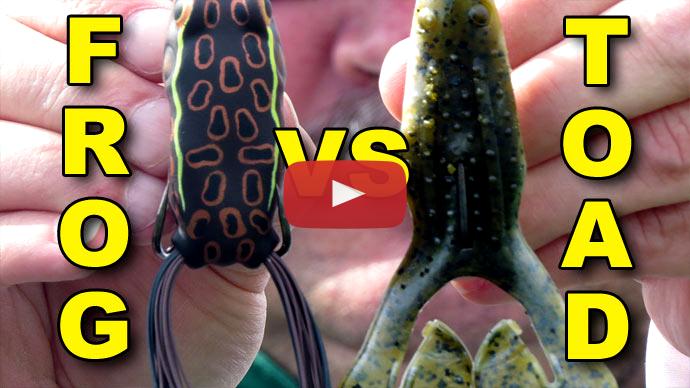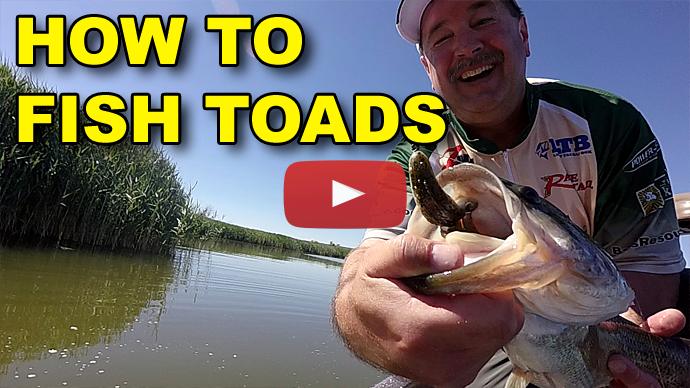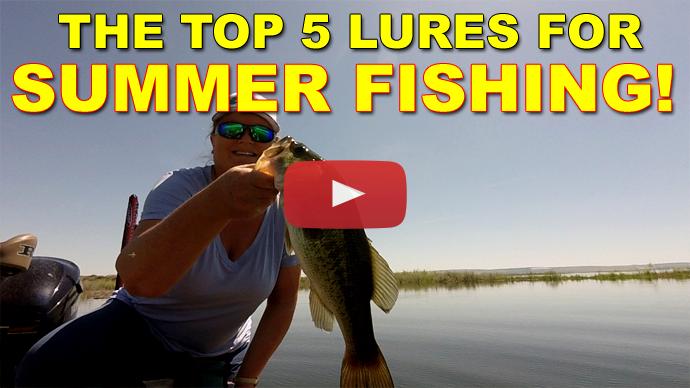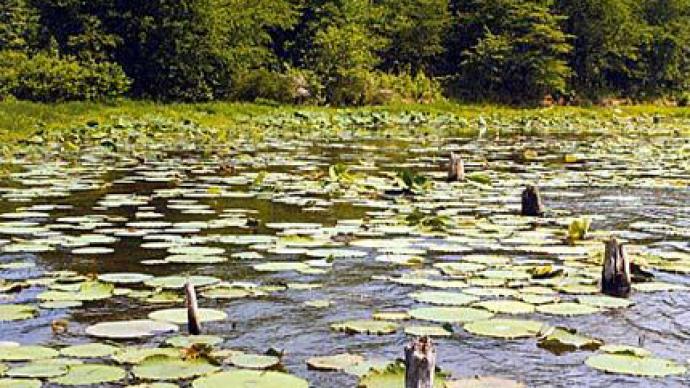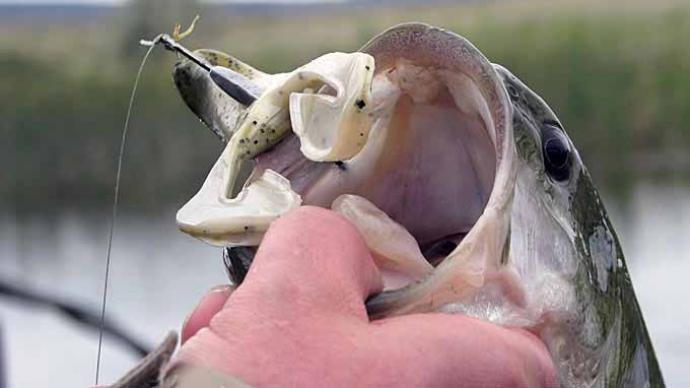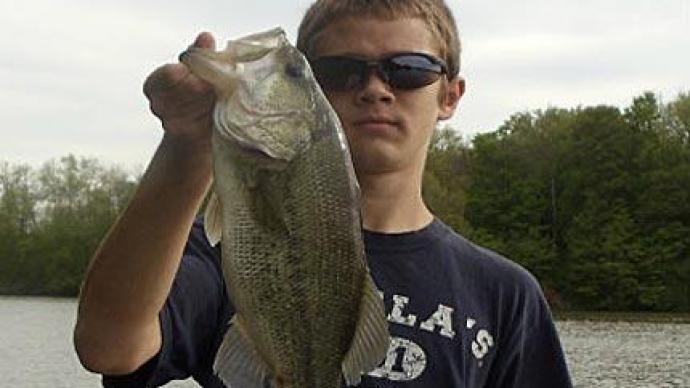Glenn: Hey folks, Glenn May here of BassResource.com. And today, I want to talk to you about frog fishing. One of the most fun ways to catch bass is with frogs. Hollow body frogs specifically. That's what I'm talking about. It can be really exciting. A lot of people enjoy fishing this way. So, I want to talk to you a little bit, first of all, how to rig these up and then how to fish them.
So, first of all, what I got here is the Booyah Pad Crasher, and you can see that right here. The thing about this, notice the hooks. They're right flush with the body. And you would think when then how does the fish get hooked, well, when he bites it, the body collapses, see its hollow body. Right? See that? The hooks become exposed and the fish gets hooked. Other than that, it's pretty weightless which means you can throw in a lot of things without getting it snagged up on things. The other thing you wanna notice here is look how thick and heavy these hooks are. See that? Heavy-duty stuff. So, we need to rig accordingly. We're gonna be throwing it in some heavy cover. And we need a powerful setup to be able to drive that thick hook into the fish's mouth and keep that fish up away from the cover. And don't let 'em dig and bury in it.
So, the rod we have here, this is a 7 foot 3-inch heavy rod, heavy power rod with a fast tip. You can go anywhere from, say, a 7 foot to a 7'8. Whatever you feel comfortable, there's not really a hard set rule. I like a little bit shorter rods, so I'm on the little bit shorter end of that spectrum of the 7'3.
You need a fast tip because you needed to be able to throw this frog way out there. You usually fishing large flats of matted vegetation, matted cover, so it's fan-casting.
What I mean by fan-casting is you make a cast on the 10 o'clock position, do your retrieve. The next cast is at the 11 o'clock. The next cast is at 12, and so on and so forth. You're covering a very careful selective pattern but because it's a big vast of matted weeds, you've gotta get it fired way out there and fish it thoroughly. So, you need a rod tip that’s gonna throw it out there.
I've got paired with it 50-pound Seaguar Kanzen line. And there's a real specific reason why I'm using this. First of all, braided line is...it's buoyant. I don't wanna say it floats but it's buoyant. And so that's gonna help keep this frog above the surface. You don't want any line that can sink and bring it down. Second, it's 50-pound because once you get above that 50-pound mark, it's a little harder to cast. It inhibits especially limits the casting distance. So, a 65-pound braid or higher... like I said you’re making long casts, and that sort of goes against the grain for frog fishing. So, I keep it at 50-pound.
I'm also using the Kanzen line rather than, say, Seaguar Smackdown because Kanzen, it's a thicker diameter braid. It has less...or it has more water resistance. It has more surface tension. So again, it helps keep it above the...floating on the surface. Smackdown is a really thin diameter line, great for low-vis situations but we're not worried about that, in this case. We're making a lot of commotion with this frog so the fish are going to be honing in on this. So, Kanzen is the perfect candidate for frog fishing.
With it, I've got here the Kast Assassin. KastKing Assassin reel. I'm not so concerned about gear ratio speed on it. Now, I know a lot of guys like really fast gear ratio 7:3:1 or higher. They believe that if you...the fish blows up on a frog, you can reel it in a lot faster and fire back out and try to get that fish again. Here this is a 6:3:1 gear ratio. And there's not a whole heck of a lot of difference between 6:3 and 7:1 when you're reeling in as fast as you can. When you're reeling really fast, it's maybe half a second difference, not a whole lot.
Back in the day, it shows you how long I've been fishing, decades ago, all the rage was low gear ratio reels especially for flipping and pitching when it first came out. That was what a lot of people went to. I'm talking 4:3:1, 3:5:1. Real low because they had a lot of torque, a lot of power. And the thought was that's what you need to wrench those fish. This is basically a winch. That's what you need to get those fish out of the cover.
Nowadays, it's kind of...you kind of hard pressed to find a reel that's under 6:1:1 gear ratio. So in this case, 6:3:1. I like that, I like that power for fishing and some heavy-duty slop. So, you want that...you want a little more, ummph, you know, to get that fish out of that cover.
The more important thing about it, a reel selection in this is the drag. This has 16 and a half pounds of drag. Most reels that come on the market today are around 11, 12 pounds. There're some reels that have more drag than that. This isn't the only one that's got a lot of drag power too it, but that's what you wanna look for. Something above, say, 15 pounds of drag. Again, when the fish buries up in those weeds, you need something to wrench it out, and if you've got a drag that's only 11, 12 pounds that's gonna be tough for you. So, drag is more important, in this case, than gear ratio in my opinion. All right. So that's the setup. Now, let me talk a little bit about how to fish it.
Keri: There you go.
Glenn: There we go. Boy, I had to wait. There we go. That's a decent fish.
Keri: Frog Fish!
Glenn: A mouthful of frog. A mouthful of frog, look at that. See that? See that? That's the key folks. When you're...when you're fishing frogs, you gotta wait for it.
Don't set the hook right away when they blow up on it. That fish right there, you blew up on it and I waited and waited and waited until I saw the line swimming off. And then I tightened down on just to make sure he had a good bite it and set the hook. What you wanna do is have a little bit of slack in that. So, if you let it tighten up too much and set the hook, you just gonna pull his head. So, in one swift motion, drop the rod tip and yank really hard. It's like cracking a whip. By throwing that slack in there, you can drive these big, thick hooks right into his face.
Gotcha, buddy. All right, let's let you go. Going down over here.
The first thing about the Booyah Pad Crasher to know is it's kind of...it's belly weighted. It's got a little keel to it, so when you throw it it almost always lands right on its stomach, which is great. You want it to float the correct way. And that's the key to it. It floats.
Use that to your advantage, guys. If you're throwing it down just cranking it back in, then you're not using the hollow body frog the way it's designed. They float, which means you can let it sit in one spot for a long period of time. That's what it's for. That's the type of fishing we're doing here. You wanna throw it out there, let it sit. You don't even bring, reel it in. Just let it sit for a little while and then slowly bring it back, make a little bit of disturbance on the water. I'd like to twitch the reel handle a little bit, twitch the rod a little bit to give a little action and then pause, and let it sit. And I'll let it bake there for 10, 15 seconds, may be more.
If I'm fishing heavy matted cover, I'll get it over to like a spot that's open, like a little opening and let it sit, up to a minute. Don't even move it. Just let it sit for a minute and then give it a little twitch with your rod tip and let it sit a long time again.
My retrieves can last 5, 6 minutes on one cast. You just work it very, very slowly because that's the whole thing behind a floating frog like this. It's not gonna get hung up in those weeds, and it's gonna sit there and float. You can just bug a fish. You can basically entice him into biting. I like to throw it also in flooded bushes, flooded timber, in and around that. I'll work it through that area, find a little pocket and let it sit right in there and just twitch it.
Keri: There you go.
Glenn: There we go.
Keri: What did I say?
Glenn: Right here. Oh boy, come here. Come here, honey. You ate that thing. Both hooks. With both hooks, look at that. Look at that. Both hooks right in its face. Think he wanted that? Again, just waiting. Let him blow up on it. Give it a second or two, reel it down. If you see the line swimming off, it starts to tighten up, crack that whip. Nice frogfish. Right there. Let's let this guy go.
Sometimes what's really fun, throw it over a little branch of a bush or a tree. Throw over the branch, let it hang there. You can just dip it. Dip it up and down. Let it sit in the water a little bit, then pick it back up and plop it right back down in place. And that can annoy a fish to death and he’ll end up smacking it. I mean, just think about ways that you can work a lure in place, that's how you want to work a frog.
Now, that said, you do wanna create a disturbance on the matted vegetation. Say, matted hydrilla, matted milfoil, and this right out of the box is not too heavy of a lure. And you gotta make a disturbance, and when that vegetation is really matted thick over, this is just gonna come up, you'll know the difference. You throw it out there, just kind of pulling across the top. It's not even making any disturbance at all on the surface.
Well, here's the trick that I like to do. Go to Walmart, get yourself some BBs, just like you would for a Daisy BB gun. With this frog, you can take it and flip it around. Grab the hooks and just flip it around like this, so it's flipped over. Now, if you notice here, look at that hole, see that? You've got a little hole right there. You can put the BBs in right there. So, what I like to do is just drop a few in there, maybe 5 or 10 BBs, not a whole lot, doesn't take much. But what you're doing is you're giving a little bit of weight so it creates a little more disturbance on the surface. And you just flip the hooks back around like I just did, and you're good to go.
You might have to go as much as, say, 15 or 20 BBs but really that's an extreme case. That puts or gives about an ounce and a half weight, so that's a pretty heavy bait. But give it just a little bit of weight like that and that's going to create that disturbance that those fish need when they're sitting up underneath those weeds to hone in on this bait.
One more thing I wanna talk about is the color. Believe it or not color can make a difference. I know a lot of people think the fish is looking up and all they see is a shadow. I've seen a difference when I'm going to a color like this, to more of a multicolored, like it's a frog pattern. So it's more of a camo pattern or just a straight white belly. I have noticed when fish are coming up and looking at it and swimming away from it, or they blow up on it but they're not taking it. Just change the color and that will get them to commit and you'll end up catching a lot of fish.
So, I hope those tips help. For more tips and tricks and for the answers to all your questions about bass fishing, visit BassResource.com.

